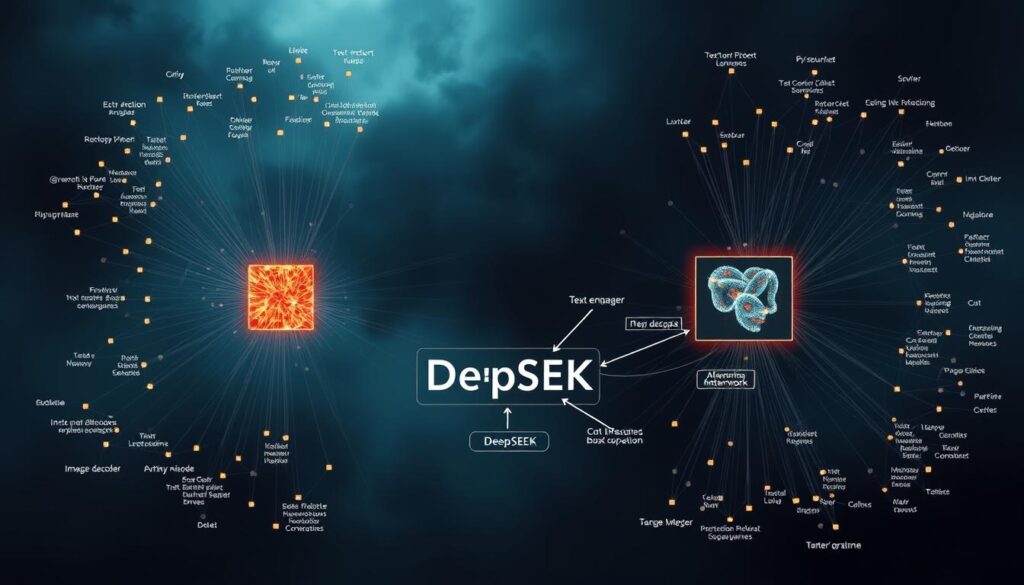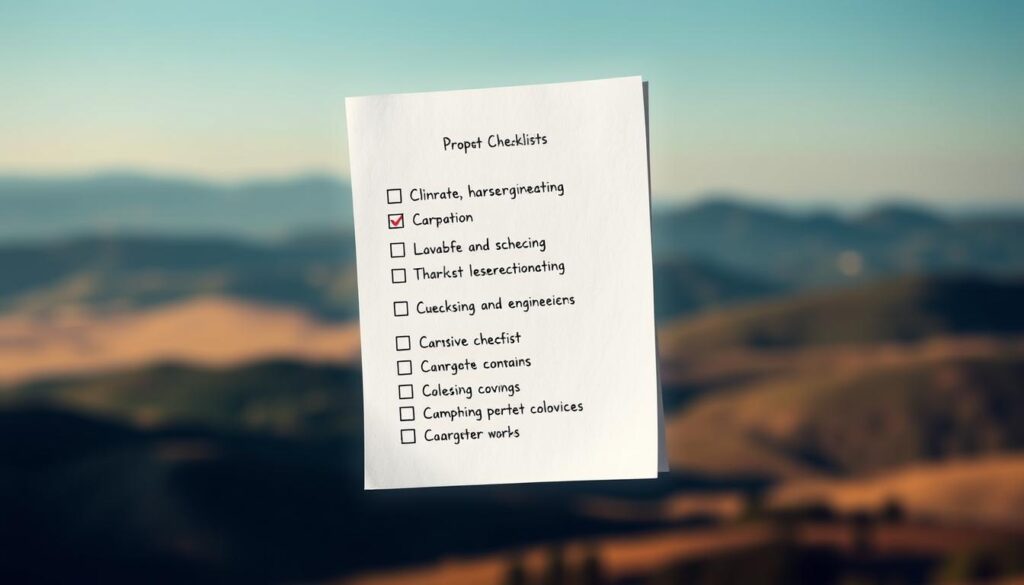Learning to write prompts for DeepSEEK is essential to get the most out of it. This guide will walk you through step-by-step tips for writing deepseek prompts. You’ll learn how to create clear, specific instructions that lead to accurate and creative results.
Whether you’re new to AI tools or want to improve your skills, you’ll find strategies to boost DeepSEEK’s performance. This includes for storytelling, business projects, and more.

Key Takeaways
- Learn how to write prompts for DeepSEEK that align with its technical capabilities.
- Discover writing tips for deepseek prompts to avoid ambiguity and improve results.
- Understand how to structure instructions for better accuracy and creativity.
- Explore formatting techniques and context strategies for optimal outputs.
- Gain troubleshooting methods to refine prompts and enhance DeepSEEK’s performance.
Understanding DeepSEEK’s Capabilities and Limitations
DeepSEEK is a top choice for AI content creation. It offers features that meet the needs of professionals and creatives. Its advanced model can handle a wide range of deepseek writing prompts, from technical reports to creative stories.
It stands out because it focuses on clear and context-rich content. This makes it perfect for specific tasks.

What Sets DeepSEEK Apart from Other AI Tools
- It’s trained on vast datasets, making it better at handling complex topics than tools like ChatGPT.
- Users can customize its output to fit their style guides, ensuring consistency in deepseek writing prompts.
- It tracks context well, reducing errors in multi-step tasks better than standard AI models.
Technical Specifications and Model Architecture
DeepSEEK is powered by a large neural network with 175 billion parameters. It’s designed for creating long-form content. Its training data is from 2023, keeping it relevant for deepseek content prompts in today’s world.
The system can handle multiple languages and checks facts in real-time.
Content Generation Strengths and Boundaries
DeepSEEK shines in tasks that need a logical structure, like business plans or research summaries. It’s also accurate in STEM topics and legal documents. But, it might struggle with creative tasks like poetry, lacking emotional depth.
It also needs precise language for technical terms. Users should avoid vague deepseek content prompts to get better results.
The Fundamentals of How to Write Prompts for DeepSEEK
Learning how to write prompts for deepseek begins with understanding its basics. Start by making prompts clear and simple. Use short, direct sentences and know what you want from DeepSEEK. This could be ideas, data analysis, or creative writing.

writing strategies for deepseek prompts also focus on context. Begin with a brief sentence to set the topic, tone, and length. For instance, “Write a 300-word article about climate change in a formal tone, focusing on recent scientific studies.” This helps DeepSEEK stay focused and consistent.
- Keep prompts between 1-3 sentences to avoid ambiguity.
- Specify tone (professional, casual, etc.) to align with your needs.
- Balance detail: Too little leaves room for irrelevant content; too much stifles creativity.
Try different primers to see how they affect responses. If the results aren’t what you expected, tweak your prompt. By getting these basics right, you’re ready to explore more advanced techniques like using templates and formatting.
Crafting Clear and Specific Instructions
Effective prompts for DeepSeek need clear and structured language. Writing tips for DeepSeek prompts help the AI understand what you want. Use direct commands and avoid vague terms to get better responses.

Using Directive Language Effectively
Use command verbs like generate, analyze, and compare to guide DeepSeek. Replace passive verbs with active ones to avoid confusion. For example, “Outline a business plan” becomes “Develop a 3-step marketing strategy with budget breakdowns.”
- Use “Create” instead of “Can you make?”
- Specify formats: “List 5 benefits in bullet points”
- Add constraints: “Solve this equation using algebraic methods”
Avoiding Ambiguity in Your Requests
Avoid vague terms like “good” or “some” to prevent confusion. Clearly define what you need to avoid off-topic answers. Here are some common issues and how to fix them:
| Ambiguous Request | Effective Prompt for DeepSeek |
|---|---|
| Write a story about a hero | Create a 500-word fantasy story where a knight defeats a dragon using a magic sword, including dialogue and a moral lesson |
| Describe a healthy meal | Design a 400-calorie dinner recipe with grilled salmon, roasted vegetables, and quinoa, listing cooking times and seasoning ratios |
Structuring Multi-Part Instructions
For complex tasks, break them down into steps. Follow these guidelines:
- Split requests into numbered phases
- Use conditional phrases like “First, research…” and “Next, analyze…”
- Highlight priorities with first, then, and finally
Example: “First, outline a startup’s product roadmap. Then, draft a 2-paragraph pitch using bullet points. Lastly, suggest 3 investor outreach strategies.”
Leveraging Context and Background Information
Clear context makes generic questions into specific deepseek prompts. Tell DeepSEEK who you’re talking to, why, and what you’re discussing. This helps get answers that match your needs, making them more relevant.

- Role Prompting: Tell DeepSEEK to act like a historian, marketer, or tech expert. For example: “Write a product review from the perspective of a first-time parent.”
- Reference Examples: Give DeepSEEK examples or style guides to follow. Saying “similar to Hemingway’s concise prose” helps with tone and structure.
- Knowledge Baselines: Explain special terms early on. If talking about quantum physics, say “explain concepts assuming no prior knowledge.”
Good prompts for deepseek need the right amount of detail. Too much context can confuse the AI, while too little leads to off-topic answers. Use phrases like “building on our earlier discussion about…” for ongoing talks. Try different ways of asking to find the best approach for your needs. These steps help you master more advanced techniques later on.
Formatting Techniques to Enhance DeepSEEK Responses
Proper formatting turns simple questions into clear instructions for DeepSEEK. By learning how to structure things, users can get results that are both professional and creative. These methods help make deepseek writing prompts clear and actionable.
Using Markdown and HTML for Structure
Markdown and HTML tags let users create layouts in their prompts. They can add headers, bullet points, or tables with tags like ## Subheading or <table>. For example, asking for a “product report with bullet points” gets you structured lists.
Users can also make key terms bold or highlight sections to draw attention to important parts.
Implementing Templates for Consistent Outputs
Templates are key in writing strategies for deepseek prompts. They save time by providing frameworks for common tasks like:
- Business proposals with set sections
- Blog outlines with clear headings
- Comparison charts in table format
Using templates keeps reports, emails, or creative work consistent. This means you don’t have to start from scratch every time.
Creating Custom Output Formats
Advanced users can create unique formats for their needs. They can ask for JSON structures for data or specific formatting rules for content. For example, asking for “responses as a 3-column table” gets you exactly what you need.
Custom markdown classes or HTML divs let users control the look of their prompts.
Creative Writing Prompts DeepSEEK Excels At
DeepSEEK turns ideas into exciting stories with special prompts. Writers can explore their creativity with prompts for stories, characters, and worlds. Let’s dive into what DeepSEEK is great at:
Storytelling and Narrative Development
DeepSEEK helps create engaging plots with clear directions. Try prompts like: “Write a thriller where a protagonist finds a time-loop mystery.” It’s all about the pace and emotions. DeepSEEK makes sure stories have a good balance of tension and resolution.
Here’s an example:
- Genre: Sci-Fi
- Key conflict: Time paradox
- Ending requirement: Bittersweet resolution
Character Creation and Dialogue Generation
DeepSEEK helps craft detailed characters with prompts like: “Make a detective with a hidden trauma and unique speech.” It ensures characters sound real through repeated questions. You can also add more depth with follow-up questions: “Tell us more about the detective’s fear of elevators.”
Setting and World-Building Prompts
DeepSEEK makes vivid settings with prompts like: “Imagine a post-apocalyptic city with its own rules and social order.” Add details like climate, culture, and tech to make it feel real. Try different themes like cyberpunk or medieval to see how it changes.
Business Applications and Professional Use Cases
DeepSEEK goes beyond creative projects to help in professional settings where clear communication is key. Marketing teams use effective prompts for deepseek to create social media posts and emails that speak to their audience. Technical writers make complex processes easy to understand with deepseek content prompts.
Sales teams get scripts tailored for them, like “Generate 10 objections to [product] and rebuttals highlighting ROI.” Customer service teams can create automated responses that show empathy and solve problems. Here’s how to ask for business-focused help:
- Marketing: “Craft a LinkedIn post about [topic] using [brand voice] for B2B audiences”
- Technical: “Explain [process] step-by-step using non-technical language”
- Data Analysis: “Summarize [dataset] trends into a 3-point executive summary”
A SaaS company turned vague requests like “write a sales page” into detailed prompts. This included specific details on value, competitors, and pricing. It cut down on revisions by 40%.
Legal and compliance teams use prompts to write policy summaries accurately. By using industry-specific terms, they ensure the content meets their standards. DeepSEEK helps in making high-quality, on-brand content for any business need.
Troubleshooting Common DeepSEEK Prompt Issues
Even with the best writing tips for deepseek prompts, problems can arise. This section offers solutions for common issues. It helps you get the most out of DeepSEEK.
Identifying and Fixing Unclear Instructions
Unclear prompts can lead to wrong outputs. Here’s how to fix it:
- Look for vague words like “describe” or “explain” and make them more specific.
- Have someone else review your prompts to catch any mistakes or unclear parts.
- Break down complex requests into simpler steps.
Addressing Content Limitations
DeepSEEK might have limits to its output. Here are some fixes:
- Divide big topics into smaller, more focused questions.
- Add “cite verified sources” to prompts to prevent false information.
- Include “avoid speculative claims” for sensitive topics to keep answers grounded.
Refining Prompts Through Iteration
Getting how to write prompts for deepseek right takes practice. Follow this approach:
- Begin with a basic prompt and note what’s missing.
- Change the prompt based on the quality of the response—improve clarity, add constraints, or broaden the scope.
- Keep track of changes over 3–5 tries to find the best way to phrase it.
Think of this as a learning process. Turn every mistake into a chance to improve and get better results.
Advanced Strategies for Complex DeepSEEK Interactions
To get the most out of DeepSEEK, you need to go beyond simple prompts. Advanced users use special strategies for deepseek prompts. They start by linking prompts together in sequences.
For example, they might ask the AI to research a topic first. Then, they ask it to analyze the topic. Lastly, they ask it to write a report. This way, each step builds on the previous one, creating a structured process.
- Metaprompting: Tell DeepSEEK to improve its own responses. Ask it to “rewrite this section using a formal tone” after it gives you content.
- Self-critique prompts: Ask the AI to check its work against certain standards. “List three weaknesses in this argument and fix them.”
- Extended context management: Use the same keywords or summaries at the start of each prompt. This keeps the conversation flowing smoothly in long discussions.
- Collaborative workflows: Work together with DeepSEEK by adding your own input after it drafts something. For example, after it writes a proposal, you can edit it and send it back with new instructions.
In real life, DeepSEEK can help with legal research. It starts by gathering case law, then compares precedents, and ends by writing a memo. These strategies turn DeepSEEK into a valuable assistant, not just a one-time helper.
Keep improving by testing your prompts, noting what’s missing, and refining your sequences. The key to mastering DeepSEEK is to see it as a dynamic partner in solving complex problems.
Conclusion: Evolving Your DeepSEEK Prompt Writing Skills
DeepSEEK’s power grows with every better prompt. By using strategies like clear instructions and advanced formatting, users get the results they want. Starting with deepseek prompt ideas helps beginners, while experts use engaging prompts for deepseek for complex tasks.
Regular practice makes it easier to match prompts with goals. Whether it’s for stories, reports, or technical solutions, the skills improve.
Testing is essential. Try different ways of saying things to see how the output changes. For instance, making a narrative prompt more specific can turn a vague scene into a detailed story. Keeping track of results helps find what works best for you, making it easier to adapt as DeepSEEK changes.
Knowing about DeepSEEK’s updates is important. Online forums and official guides share new insights. This helps users keep their strategies up-to-date. Clear and specific prompts lead to better results, whether for marketing or academic writing.
Getting better takes practice. Seeing each prompt as a chance to learn leads to big improvements. As AI tools get better, being able to write good prompts becomes a key advantage. Be curious and keep exploring to get better at DeepSEEK.
FAQ
What are the key components of effective prompts for DeepSEEK?
Good prompts for DeepSEEK are clear and specific. They need enough context. It’s key to tell DeepSEEK what you want and how to get there. But also, let it be creative.
How can I avoid ambiguity in my DeepSEEK prompts?
To avoid confusion, use exact words and explain any tricky terms. Make your requests clear. Use direct language to show what you expect.
Are there specific formatting techniques that enhance DeepSEEK responses?
Yes, using Markdown and HTML can make your prompts better. It helps DeepSEEK understand you better. Also, using templates and custom formats can lead to better results.
What types of creative writing prompts work best with DeepSEEK?
DeepSEEK is great for stories, characters, and worlds. Give it clear instructions and context. This way, it can create amazing stories, characters, and settings.
How should I structure prompts for business applications?
For business, make prompts clear about who and what you’re talking about. Use professional language. But also, think about what you need, like marketing or technical writing.
What should I do if DeepSEEK doesn’t produce the expected output?
If DeepSEEK doesn’t meet your expectations, check your instructions. Break down big prompts into smaller ones. Keep trying and adjusting based on what you get back.
Can I combine multiple prompts for complex tasks in DeepSEEK?
Yes, you can link prompts together for complex tasks. This keeps the flow and helps DeepSEEK handle more detailed questions.
What strategies can help me craft engaging prompts for DeepSEEK?
To make engaging prompts, use context and storytelling. Ask open-ended questions. Adding specific scenarios can make DeepSEEK’s answers more creative and fitting.

















